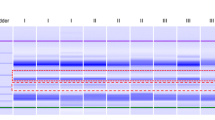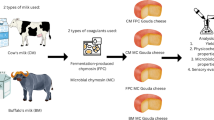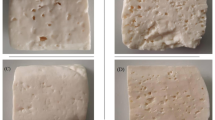Abstract
Greek protected designation of origin (PDO) cheeses are well-known for their quality and nutritive value. One hundred and twelve samples from 21 Greek PDO cheeses, a non-PDO and a potential PDO were analyzed for fatty acid (FA) profile and several physicochemical parameters including moisture, fat on dry matter (FDM), protein content, pH and salt content. Analyzed hard and semi-hard cheeses were Sfela, Kefalograviera, Kasseri, Ladotyri Mytilinis, Formaella Arachovas Parnassou, Graviera Agrafon, Graviera Kritis, Metsovone, Graviera Naxou, Mastelo, Batzos and San Michali. Soft, spread and whey cheeses included Kopanisti, Xynomyzithra Kritis, White cheese, Kalathaki Limnou, Manouri, Feta, Xygalo Siteias, Galotyri, Katiki Domokou, Pichtogalo Chanion and Anevato. The profile of 37 FAs combined with physiochemical properties was utilized to discriminate cheeses by label (cheese identity), cheese type (hard, semi-hard, soft, spread and whey) and milk type (cow, goat, sheep and combinations). The study found that Sfela had the highest salinity, Manouri the highest FDM and San Michali the highest content of proteins. Regarding FAs, the dominant ones in almost all cheeses were C14:0, C16:0, C18:0 and cis-9 C18:1. For classification concerning cheese identity, the most significant parameters were moisture, fat, C18:2n-6c, pH and salt. The most significant discriminants by cheese type were pH, moisture, FDM, salt and C16:0 while C10:0, C11:0, C14:1, C18:2n-6c, C20:0, C20:3n-6 and saturated FAs were more influential to separate by milk type. Results depict the FA profile of Greek PDO cheeses and show that in combination with physicochemical characteristics can be used as authenticity markers.


Similar content being viewed by others
References
Haug A, Høstmark AT, Harstad OM (2007) Bovine milk in human nutrition—a review. Lipids Health Dis 6(1):25
Huth PJ, DiRienzo DB, Miller GD (2006) Major scientific advances with dairy foods in nutrition and health. J Dairy Sci 89(4):1207–1221
Karoui R (2017) Methodologies for the characterization of the quality of dairy products. In: Toldrá F (ed) Advances in food and nutrition research. Academic Press Inc, Cambridge, pp 237–275
López-Expósito I, Amigo L, Recio I (2012) A mini-review on health and nutritional aspects of cheese with a focus on bioactive peptides. Dairy Sci Technol 92(5):419–438
Andrikopoulos NK, Kalogeropoulos N, Zerva A, Zerva U, Hassapidou M, Kapoulas VM (2003) Evaluation of cholesterol and other nutrient parameters of Greek cheese varieties. J Food Compos Anal 16(2):155–167
Samelis J, Kakouri A, Pappa EC, Matijašić BB, Georgalaki MD, Tsakalidou E, Rogelj I (2010) Microbial stability and safety of traditional Greek Graviera cheese: characterization of the lactic acid bacterial flora and culture-independent detection of bacteriocin genes in the ripened cheeses and their microbial consortia. J Food Prot 73(7):1294–1303
Zlatanos S, Laskaridis K, Feist C, Sagredos A (2002) CLA content and fatty acid composition of Greek Feta and hard cheeses. Food Chem 78(4):471–477
EU, European Commision, Food, farming, fisheries, food safety and quality, certification, quality labels, EU quality food and drink, Feta PDO (2019) https://ec.europa.eu/info/food-farming-fisheries/food-safety-and-quality/certification/quality-labels/eu-quality-food-and-drink/feta_en. Accessed 3 May 2020
Litopoulou-Tzanetaki E, Tzanetakis N (2011) Microbiological characteristics of Greek traditional cheeses. Small Rumin Res 101(1–3):17–32
Litopoulou-Tzanetaki E, Tzanetaki N (2014) The microfloras of traditional Greek cheeses. Microbiol Spectr 2(1):1–34
ITA, The International Trade Administration, U.S. Department of Commerce (2019) https://www.export.gov/apex/article2?id=Greece-Agricultural-Sector. Accessed 3 May 2020
Danezis GP, Tsagkaris AS, Brusic V, Georgiou CA (2016) Food authentication: state of the art and prospects. Curr Opin Food Sci 10:22–31
EU (2020) European Union, eAmbrosia—the EU geographical indications register. https://ec.europa.eu/info/food-farming-fisheries/food-safety-and-quality/certification/quality-labels/geographical-indications-register/. Accessed 3 May 2020
Danezis GP, Tsagkaris AS, Camin F, Brusic V, Georgiou CA (2016) Food authentication: techniques, trends & emerging approaches. TrAC Trends Anal Chem 85:123–132
Amrutha Kala AL (2012) A survey of lipid composition of Khoa samples in relation to possible adulteration. Int J Dairy Technol 65(3):444–450
Kim JM, Kim HJ, Park JM (2015) Determination of milk fat adulteration with vegetable oils and animal fats by gas chromatographic analysis. J Food Sci 80(9):1945–1951
Ntakatsane MP, Liu X, Zhou P, Mothibe KJ, Adegoke GO, Odenya WO (2014) Characterization of fatty acid profile by FFFS. J Food Meas Charact 8(1):1–8
Park JM, Kim NK, Yang CY, Moon KW, Kim JM (2014) Determination of the authenticity of dairy products on the basis of fatty acids and triacylglycerols content using GC analysis. Korean J Food Sci Anim Resour 34(3):316
Perotti MC, Rebechi SR, Bernal SM (2005) Detection of adulterations in milk fat by multiple regression analysis of total fatty acids profile. Grasas Aceites 56(1):67–74
de Oliveira MT, Porto BL, Bell MJV, Perrone ÍT, de Oliveira MAL (2016) Capillary zone electrophoresis for fatty acids with chemometrics for the determination of milk adulteration by whey addition. Food Chem 213:647–653
Povolo M, Pelizzola V, Lombardi G, Tava A, Contarini G (2012) Hydrocarbon and fatty acid composition of cheese as affected by the pasture vegetation type. J Agric Food Chem 60(1):299–308
Povolo M, Pelizzola V, Passolungo L, Biazzi E, Tava A, Contarini G (2013) Characterization of two Agrostis-Festuca alpine pastures and their influence on cheese composition. J Agric Food Chem 61(2):447–455
Tsiplakou E, Mountzouris K, Zervas G (2006) Concentration of conjugated linoleic acid in grazing sheep and goat milk fat. Livest Sci 103(1–2):74–84
Tsiplakou E, Kominakis A, Zervas G (2008) The interaction between breed and diet on CLA and fatty acids content of milk fat of four sheep breeds kept indoors or at grass. Small Rumin Res 74(1–3):179–187
Vieitez I, Irigaray B, Callejas N, González V, Gimenez S, Arechavaleta A, Grompone M, Gámbaro A (2016) Composition of fatty acids and triglycerides in goat cheeses and study of the triglyceride composition of goat milk and cow milk blends. J Food Compos Anal 48:95–101
Tsiplakou E, Mountzouris K, Zervas G (2006) The effect of breed, stage of lactation and parity on sheep milk fat CLA content under the same feeding practices. Livest Sci 105(1–3):162–167
Tsiplakou E, Zervas G (2013) Changes in milk and plasma fatty acid profile in response to fish and soybean oil supplementation in dairy sheep. J Dairy Res 80(2):205–213
Tsiplakou E, Zervas G (2013) The effect of fish and soybean oil inclusion in goat diet on their milk and plasma fatty acid profile. Livest Sci 155(2–3):236–243
Zervas G, Tsiplakou E (2011) The effect of feeding systems on the characteristics of products from small ruminants. Small Rumin Res 101(1–3):140–149
Reis Lima MJ, Bahri H, Sá Morais J, Veloso ACA, Fontes L, Lemos ET, Peres AM (2019) Assessing Serra da Estrela PDO cheeses’ origin-production date using fatty acids profiles. J Food Meas Charact 13(4):2988–2997
Danezis GP, Pappas AC, Tsiplakou E, Pappa EC, Zacharioudaki M, Tsagkaris AS, Papachristidis C, Sotirakoglou K, Zervas G, Georgiou CA (2019) Authentication of Greek PDO cheeses through elemental metabolomics. Int Dairy J 104:104599
Greek Codex Alimentarius (2014) https://www.gcsl.gr/media/trofima/83.pdf. Accessed 3 May 2020
Schneider C (1954) Traite pratique des essais du lait et du controle des produits laitiers du Dr. N. Gerber. Berne, Switzerland
Kosikowski FV (1982) Cheese and fermented milk food. Edwards Brothers, Michigan
International Dairy Federation (1993) Milk. Determination of nitrogen content. IDF Standard 20B. Brussels, Belgium
International Dairy Federation (1982) Cheese and processed cheese. Determination of the total solids content. IDF Standard 4A. Brussels, Belgium
Folch J, Lees M, Sloane Stanley G (1957) A simple method for the isolation and purification of total lipids from animal tissues. J Biol Chem 226(1):497–509
Domagała J, Sady M, Grega T, Pustkowiak H, Florkiewicz A (2010) The influence of cheese type and fat extraction method on the content of conjugated linoleic acid. J Food Compos Anal 23(3):238–243
Kelly ML, Berry JR, Dwyer DA, Griinari JM, Chouinard PY, Van Amburgh ME, Bauman DE (1998) Dietary fatty acid sources affect conjugated linoleic acid concentrations in milk from lactating dairy cows. J Nutr 128(5):881–885
Ulbricht T, Southgate D (1991) Coronary heart disease: seven dietary factors. Lancet 338(8773):985–992
Indumathi K, Kaushik R, Arora S, Wadhwa B (2015) Evaluation of iron fortified Gouda cheese for sensory and physicochemical attributes. J Food Sci Technol 52(1):493–499
Khan IT, Nadeem M, Imran M, Ajmal M, Ali S (2018) Antioxidant activity, fatty acids characterization and oxidative stability of Gouda cheese fortified with mango (Mangifera indica L.) kernel fat. J Food Sci Technol 55(3):992–1002
Or-Rashid MM, Odongo NE, Subedi B, Karki P, McBride BW (2008) Fatty acid composition of yak (Bos grunniens) cheese including conjugated linoleic acid and trans-18:1 fatty acids. J Agric Food Chem 56(5):1654–1660
Küçüköner E, Haque ZU (2006) Physicochemical properties of low-fat and full-fat Cheddar cheeses. Int J Dairy Technol 59(3):166–170
Møller KK, Rattray FP, Bredie WLP, Høier E, Ardö Y (2013) Physicochemical and sensory characterization of Cheddar cheese with variable NaCl levels and equal moisture content. J Dairy Sci 96(4):1953–1971
Addis M, Fiori M, Riu G, Pes M, Salvatore E, Pirisi A (2015) Physico-chemical characteristics and acidic profile of PDO Pecorino Romano cheese: seasonal variation. Small Rumin Res 126:73–79
Karupaiah T, Tan CH, Chinna K, Sundram K (2011) The chain length of dietary saturated fatty acids affects human postprandial lipemia. J Am Coll Nutr 30(6):511–521
Zlatanos S, Laskaridis K (2009) Variation in the conjugated linoleic acid content of three traditional Greek cheeses during a 1-year period. J Food Qual 32(1):84–95
Peterson DG, Kelsey JA, Bauman DE (2002) Analysis of variation in cis-9, trans-11 conjugated linoleic acid (CLA) in milk fat of dairy cows. J Dairy Sci 85(9):2164–2172
Donmez M, Kemal Seckin A, Sagdic O, Simsek B (2005) Chemical characteristics, fatty acid compositions, conjugated linoleic acid contents and cholesterol levels of some traditional Turkish cheeses. Int J Food Sci Nutr 56(3):157–163
Prandini A, Sigolo S, Piva G (2011) A comparative study of fatty acid composition and CLA concentration in commercial cheeses. J Food Compos Anal 24(1):55–61
Prandini A, Sigolo S, Tansini G, Brogna N, Piva G (2007) Different level of conjugated linoleic acid (CLA) in dairy products from Italy. J Food Compos Anal 20(6):472–479
Segato S, Galaverna G, Contiero B, Berzaghi P, Caligiani A, Marseglia A, Cozzi G (2017) Identification of lipid biomarkers to discriminate between the different production systems for Asiago PDO cheese. J Agric Food Chem 65(45):9887–9892
Hauswirth CB, Scheeder MR, JrH B (2004) High ω-3 fatty acid content in alpine cheese: the basis for an alpine paradox. Circulation 109(1):103–107
Uzun P, Masucci F, Serrapica F, Napolitano F, Braghieri A, Romano R, Manzo N, Esposito G, Di Francia A (2018) The inclusion of fresh forage in the lactating buffalo diet affects fatty acid and sensory profile of mozzarella cheese. J Dairy Sci 101(8):6752–6761
Caroprese M, Sevi A, Marino R, Santillo A, Tateo A, Albenzio M (2013) Composition and textural properties of Mozzarella cheese naturally-enriched in polyunsaturated fatty acids. J Dairy Res 80(3):276–282
Romano R, Giordano A, Chianese L, Addeo F, Musso SS (2011) Triacylglycerols, fatty acids and conjugated linoleic acids in Italian Mozzarella di Bufala Campana cheese. J Food Compos Anal 24(2):244–249
Adamska A, Rasińska E, Rutkowska J, Antoniewska A (2017) Fatty acid profile of commercial Camembert-and Brie-type cheeses available on the Polish market. CYTA-J Food 15(4):639–645
Valdivielso I, de Renobales M, Aldai N, Barron LJR (2017) Changes in terpenoid composition of milk and cheese from commercial sheep flocks associated with seasonal feeding regimens throughout lactation. J Dairy Sci 100(1):96–105
Markiewicz-Kęszycka M, Czyżak-Runowska G, Lipińska P, Wójtowski J (2013) Fatty acid profile of milk—a review. Bull Vet Inst Pulawy 57(2):135–139
Stergiadis S, Nørskov NP, Purup S, Givens I, Lee MR (2019) Comparative nutrient profiling of retail goat and cow milk. Nutrients 11(10):2282
Tsiplakou E, Zervas G (2008) Comparative study between sheep and goats on rumenic acid and vaccenic acid in milk fat under the same dietary treatments. Livest Sci 119(1–3):87–94
Cabiddu A, Delgadillo-Puga C, Decandia M, Molle G (2019) Extensive ruminant production systems and milk quality with emphasis on unsaturated fatty acids, volatile compounds, antioxidant protection degree and phenol content. Animals 9(10):771
Acknowledgements
We acknowledge support of this work by the project “FoodOmicsGR Comprehensive Characterisation of Foods” (MIS 5029057) which is implemented under the Action “Reinforcement of the Research and Innovation Infrastructure”, funded by the Operational Programme “Competitiveness, Entrepreneurship and Innovation” (NSRF 2014–2020) and co-financed by Greece and the European Union (European Regional Development Fund).

Author information
Authors and Affiliations
Corresponding author
Additional information
Publisher's Note
Springer Nature remains neutral with regard to jurisdictional claims in published maps and institutional affiliations.
Electronic supplementary material
Below is the link to the electronic supplementary material.
Rights and permissions
About this article
Cite this article
Danezis, G.P., Tsiplakou, E., Pappa, E.C. et al. Fatty acid profile and physicochemical properties of Greek protected designation of origin cheeses, implications for authentication. Eur Food Res Technol 246, 1741–1753 (2020). https://doi.org/10.1007/s00217-020-03527-7
Received:
Revised:
Accepted:
Published:
Issue Date:
DOI: https://doi.org/10.1007/s00217-020-03527-7




